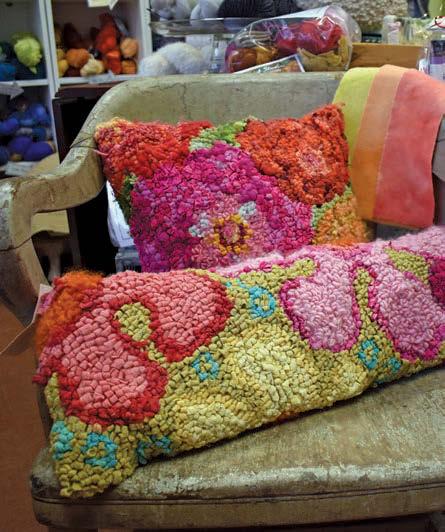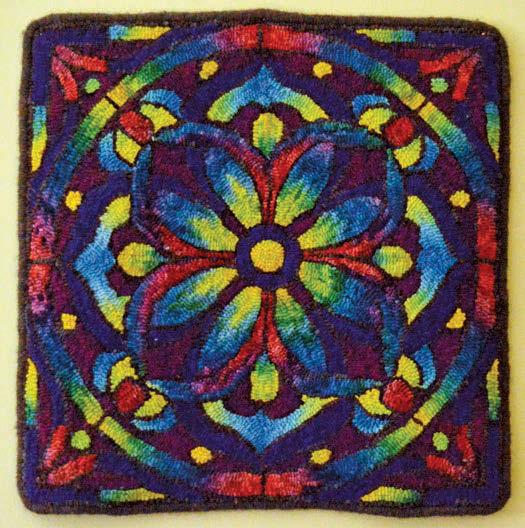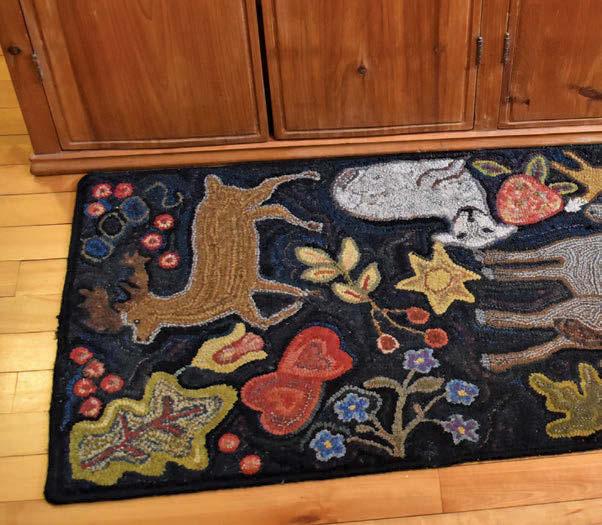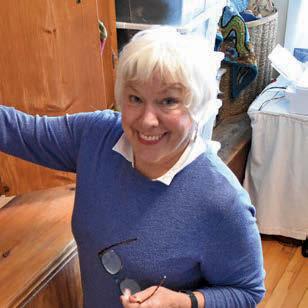
6 minute read
Décor: Go traditional with hooked rugs
These chicken-themed coasters by Mary Ploughman Jones add whimsy to any table setting.
Go traditional with hooked rugs
Three Atlantic Canadian crafters share their love for this old-time technique

BY ALISON JENKINS
DEANNE FITZPATRICK AMHERST, N.S. Donning a black work smock, Deanne Fitzpatrick sits down to a hooked rug in progress at her Amherst studio. Picking up a hook in one hand and a strip of woollen fabric in the other, she hooks as she talks.
“My grandmother hooked rugs,” she says. “It’s a traditional craft. It’s one of the few crafts that’s thought to be indigenous to North America.” Hooked rugs first appeared on the North American eastern seaboard in the 1840s and 1850s, using wool cloth and burlap backing. Derived from other needle techniques, it’s believed resourceful settlers used what was at hand like feed bags and the family’s old clothes.
Fitzpatrick founded her eponymous studio in her home 27 years ago, and grew it into a large shop, workspace, and studio downtown. She stocks her shelves with vibrant hues of wool cloth and yarns and decorates the walls with her own art rugs. Kits for sale feature some of her original designs, with everything you need to make your own rug.
“I’ve always felt like the most important thing that I do is hook rugs and write,” says Fitzpatrick, who released her seventh book, Making a Life: Twenty-five Years of Hooking Rugs (Nimbus Publishing), last year. Rugs have an energy that livens up a room, she says. “I always say they’re good company. They add a little life to a room that doesn’t happen without them. You need textiles.” Large, lush landscapes conquer the walls of her shop. Smaller pieces warm tiny spaces.
Fitzpatrick prefers to pin her mats directly to the wall using map pins. Some of her work is mounted on a board in a custom narrow black wood frame.


Fitzpatrick says rug hooking is a part of Atlantic Canadian culture. “Culture is a very, very important thing. I think, it’s really easy now with everyone having access to the same ideas and the same materials online, that we do what we can to preserve what’s uniquely ours. I can’t tell you how important I think that is… Who we were is who we are.”
ANNE LOCKHART CHARLOTTETOWN, P.E.I. On P.E.I., hooking remains a popular pastime for Anne Lockhart. The retired teacher won an artist’s grant and attended rug school in the United States, and completed the Rug Hooking Guild of Nova Scotia’s program at Mount St. Vincent University in Halifax.
Sipping tea in her off-grid summer cottage turned year-round home, Lockhart says, “Hooking is just pulling up a loop.” Throughout her cozy space, rugs decorate the wooden walls and floors.
A hooked vignette of her favourite Mexican beach fills one wall. Above a teak, glass-front bookshelf is a more traditional Celtic design in navy and greens.
Lockhart continues to share her passion with other Maritime guilds and taught at P.E.I.’s community schools. All this from someone who was certain she didn’t want to make mats.
Her friends attended a workshop and encouraged her to join them, but Lockhart was happy with her family and other hobbies.
Then one day she visited her friend Patti. “Anne, you’re going to hook,” said Patti.
“Well, I didn’t really want to,” Lockhart says. Patti handed her a little maple leaf pattern on burlap and some variegated wool. “You’re going to hook.” Lockhart accepted the gift and finished the pattern. “And I was hooked,” she says now. That first leaf hangs in the stairway of her home. At the patio


Anne Lockhart.
Mary Ploughman Jones.


doors is a door mat; Lockhart’s exception to her no high-traffic and no direct sunlight rule. Above the door is a long narrow landscape made especially for the space.
“I don’t really have a colour palette,” she says. “I’m eclectic. What’s nice about rug hooking is that you don’t have to be precise.”
Some hookers are very precise, hooking even loops in neat rows. Others are more free-flowing, combining different sized strips and various materials into their fibre artwork.
“The rug has to be yours,” says Lockhart. “I don’t like teaching a pattern, I’d rather teach a process. They can take that process and do whatever they want with it.”
MARY PLOUGHMAN JONES BRACKLEY BEACH, P.E.I. A vivid, yellow flowered runner marks the landing outside Mary Ploughman Jones’ Brackley Beach condo. Inside the style is Scandinaviameets-Island farmhouse decor with white walls and slipcovers amid antique furniture. Rugs cover the floors and surfaces. Her partner Dave watches the football game with his feet resting on a rug-covered ottoman; chair pads cover nearly every seat.
“For me it’s the colour and texture that draw me in,” says Ploughman Jones. “It’s painting with wool.”
Ploughman Jones started hooking in 1989 and made a career of her art. After attending art school in Chicago, her creativity fuelled her career choices, landing in recent decades at the Dunes Gallery in Brackley Beach as curator and co-owner of Howe’s Hall Gallery in York, P.E.I.
Wool cloth stacked in cabinets and shelves and organized by colour fills her studio. Reed baskets hold yet more cloth and extra worms, strips of fabric she cut for previous projects.
Ploughman Jones describes her palette as antique colours with “a few brights thrown in from time to time.” She prefers to use recycled wool gleaned from old clothes or blankets. “I find using recycled wool gives your work a patina of age,” she says.
A semicircle mat sits at the door to the back hall. “That’s an older one, my first cat rug,” she says. The rug is from 1994 and has stood the test of time and many feet.
Two small mats in the living room are antiques, picked up along her hooking journey. You can see the recycled wool and burlap on close inspection. “They’re probably the Bluenose patterns,” she says. “It’s nice to have a mix of old and new.” o
Middle: Deanne Fitzpatrick sells an array of kits at her studio. You can order online at hookingrugs.com. Right: This rug by Anne Lockhart is still vibrant after more than 15 years.


WHERE TO PLACE YOUR RUG Floor rugs should be all the same material (traditionally wool). Different materials will wear at different rates. Keep loops an even height or the rug will flatten out and lose dimension.
Wall rugs can be various materials and feature different length loops to create dimension. Some of Ploughman Jones’ work contains jewellery, seashells, and sea glass. Fitzpatrick uses fluffy yarns and shiny fabrics alongside more traditional materials.
As with any textile, direct sunlight will fade the colour over time.
RUG CARE TIPS Never shake your rug as this breaks down the backing over time. Vacuum your rug with the brush head only, not motorized carpet heads.
To spot clean your rug, dab it with water and mild soap, but avoid rubbing.
To refresh the colours, tamp your rug face down into fresh, light snow and sweep it clean. “You’ll be amazed at how the colours pop and how clean your mat will look,” says Ploughman Jones.
Store rugs rolled up, right side out, in a breathable covering and a dry location.

New Brunswick’s largest modern furniture and lighting source.
Our selection, quality and price make it worth the visit.
Maritime Wide Delivery.






